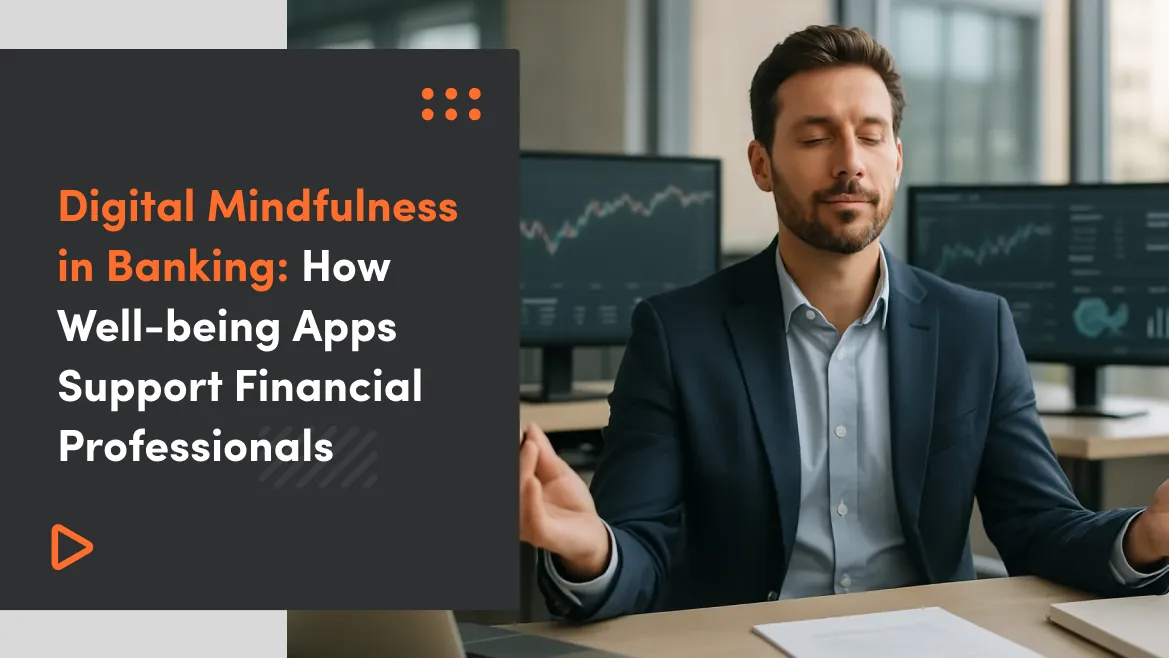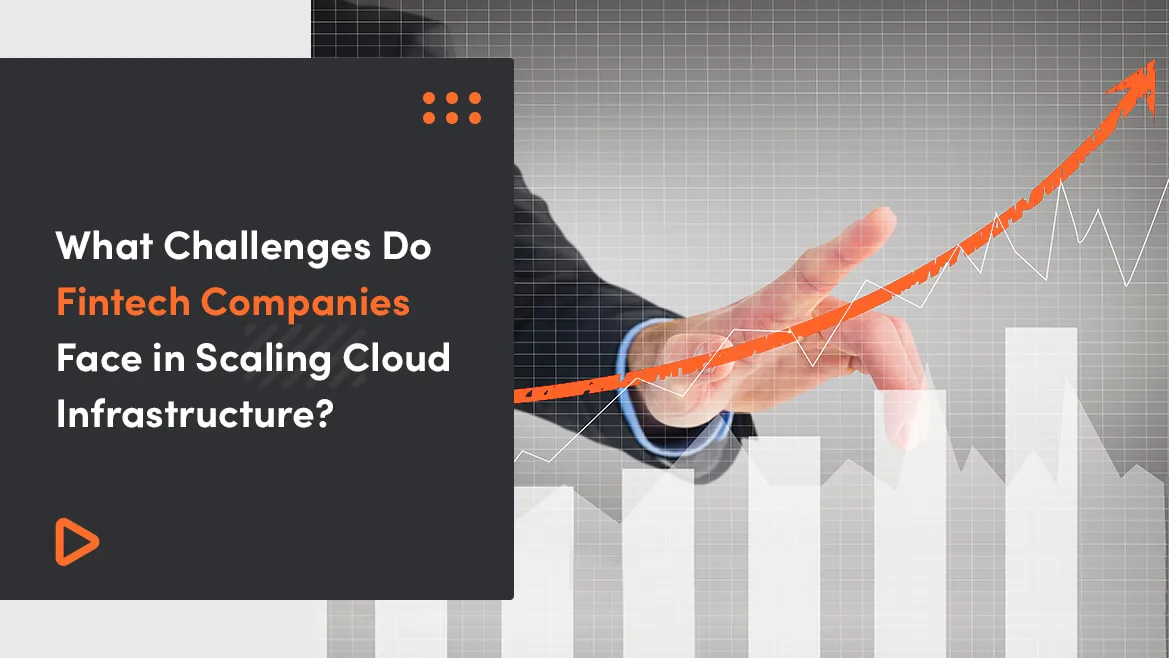If there is anything that the pandemic has shown, it is the importance of being financially stable, and how much more technology can offer to both the layperson and businessmen alike when it comes to their everyday expenses. However, the personal finance apps of today can do more than just keep track of your spending habits to help you save money at the end of the month.
In this article, we will be talking about what benefits users will have using personal finance apps and how you can fully utilize what the technology available can do to create the perfect app for the different financial functions that your target audience might need.
What is a personal finance app?
A personal finance app, at its core, is an application that tracks a person’s spending habits which is made possible because most of the time, these apps are integrated into your current and savings account. Most notably, these can be seen in internet banking which is commonplace in today’s society.
In some cases, they can even tell you how much you have spent, to the point, and how you spent it.
However, there are many versions of the app, each with a specific function and purpose, which we will go through one by one.
Types of personal finance apps
As you know, the financial world involves many responsibilities and, more often than not, not one person is able to take on the responsibility of one function on their own. It is the same for personal finance apps. This is why there are several of them available for users to explore.
Habit Trackers
Habit trackers, as their name suggests, monitor what your spending habits are. It acts as an eye-opener especially when those same habits are not showing any benefits to your financial stability, and its future. In fact, the results that these trackers show is the push that urges individuals to change their money management habits.
Budget Planners
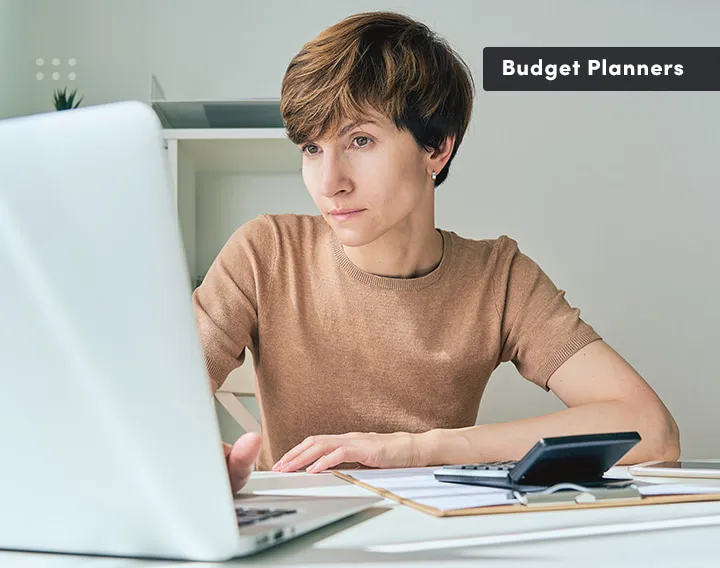
Budget-based apps simply help you determine how your monthly cash flow will be with the aim to achieve specific financial goals that you set for yourself.
Investment Apps
Acorn is just one out of many investment applications that gives you the opportunity to dive into investing minus the hassle. One of the more prominent versions of the app, similar to Acorn, works by rounding up your spending to the nearest dollar in which the difference will be invested based on how you choose to invest, which is an option you are asked about when you sign up for an account.
Basic Money Management Apps with Manual Data Entry
Having the option to manually add information in a money management app is a welcomed functional addition because, just like any software, some functions can easily crash especially when multiple people use the app simultaneously.
Among the many versions of the app is Monefy. With it, you can simply click ‘Add’ after you cue in the expense. This will automatically be added to your financial account immediately. Others even categorize each expense under a heading effectively monitoring your spending.
Peer-to-Peer Payments App
A commonplace even before the pandemic, being able to pay through the various apps is made possible because most of the apps can be connected to all your financial accounts. This gives the app access to your funds allowing you to pay those you owe directly from it.
In return, it also gives your clients the ability to pay directly to your account online, which is just as convenient to businessmen as it is to the general public.
Full-Service Banking App
A full-service banking app may have various versions of the app simultaneously running. This is the reason why some banking apps, mobile or not, are able to function as a habit tracker while being fully capable of providing peer-to-peer payment.
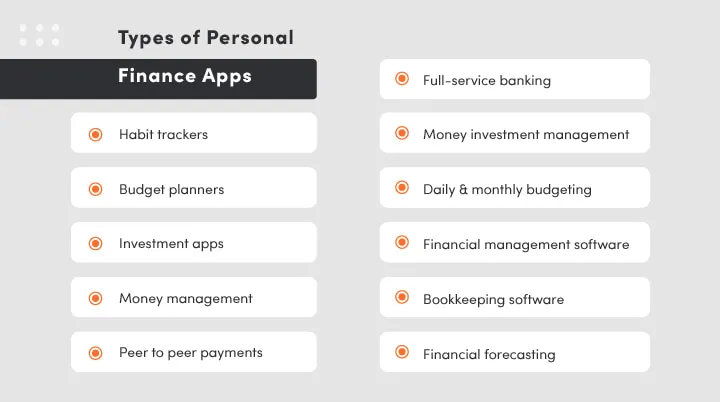
Money Investment Management App
One of the many versions of the app has been mentioned above where it uses the rounding up function and invests the difference to tracker funds. However, there are also other versions of the app that in addition to investing your money, you can also set up financial goals that may also affect how the AI will be investing your money.
Daily & Monthly Budgeting Apps
This is the main point of personal finance management - to monitor your daily expenses to hopefully create a monthly budget that will help make users become financially stable. All the other services worked into its function are highly appreciated caveats.
Financial Management Software
All versions of a personal finance app are run with financial management software. The difference between them is based on what software was used and how their user interface. However, at its core, its aim is to help each user become financially literate and stable by effectively managing their money and suggest adjustments to optimize saving money.
Bookkeeping Software
The most common software used by money management apps, this software allows tracking of your spending to account for what you have spent for the month.
Financial Forecasting Apps
These money management apps attract many users because of the suggestions that these provide, based on your cash flow and financial goals. In fact, it might even be possible to suggest realistic changes to your goals as it sees fit. However, it is ultimately up to the user if they accept any changes.
Most popular personal finance apps and what you can learn from them
With personal finance apps being around for a while, it is almost a certainty that there are those to which the public, both laymen and businessmen alike, have developed a close affinity, and below are some of those that are surely on everyone’s list.
Mint
For 13 years, Mint has proven to be one of the most effective money management apps available to the public. At its core, it is a budget-based app that monitors all your financial activity. However, it has also included peer-to-peer payment as it is now capable of managing existing standing order while providing feedback on how to allocate your monthly budget based on your spending habits.
Additionally, it is also one of the most secure ones boasting a bank-grade security system reassuring its users that the information that they are provided with does not fall into the wrong hands.
You Need a Budget
It is a budget based app which controls your spending based on four rules:
- **All your earnings will have a role to play ** - down to your last cent, each will have a role to play in your monthly budget allocated to different categories
- **Setting aside for emergencies ** - prompts you to save money for foreseen and unforeseen events
- **Adjust accordingly ** - feeds back when you overrun your budget to prompt you to change how you spend
- **Living from yesterday ** - the goal is to establish habits that allow you to live, not from paycheck to paycheck, but from the month before
The goal of YNAB is to establish sustainable financial stability for its users that they can bring forward. Unfortunately, YNAB only offers a free version of the app in its first month of use. Otherwise, there is a $50 annual subscription.
Mvelopes
An app with a simple concept, Mvelopes simply helps you clearly allocate your money into virtual individual envelopes which represent specific categories of your monthly spending. It gives its users a prompt to stop spending when the money inside the envelope runs out.
Mvelopes, however, will require its users to pay an annual subscription which will depend on whether you would like quarterly coaching and access to their learning center.
EveryDollar
Riding on YNAB’s first rule, this budget-based app gives you the ability to allocate the money as you see fit with the promise that you will be able to save money as your spending habits become clearer.
EveryDollar is a free budgeting app with a monthly subscription option that allows you to keep a closer eye on your transactions and be given feedback as it can be tied in with your bank account.
PocketGuard
PocketGuard - it is a free budgeting app that can be more than a platform to monitor and budget your finances.
It offers added services such as:
- Negotiate deals - a rare feature among the different versions of the app, better deals, especially among your subscriptions will always save you money
- Debt pay-off plan - the app has an algorithm that helps you earn more by optimizing paying off your debt
Try our developers.
Free for 2 weeks.
No risk. Just results. Get a feel for our process, speed, and quality — work with our developers for a trial sprint and see why global companies choose Selleo.
What do people expect from personal finance apps?
The positive feedback that some personal finance apps have earned throughout the years has created a benchmark for all those that already are and those which are up and coming. Additionally, the improving technology that has become available to developers furthers this notion; that it can do more than just help with money management.
Banking Apps Enter the Game
Banks have seen the benefits that budget-based applications had over the years. This is why they have looked into incorporating their functions into their internet banking with the help of already established money management applications, or for developers to create one specific for their operations.
However, if you are a developer, it might be a good idea to be proactive and approach them yourself with a proposal.
Chatbots and Virtual Assistants Steal Users
Users of money management applications are now expecting that applications have readily available webchat and virtual assistants with the latter readily available when an encountered problem is too complex for the AI to deal with.
Audience Gets Younger
Personal finance apps have been developed with the most recent technology. That is why it is only understandable that it is the younger generation who are able to adapt to them more effectively. However, this should not be an excuse for those who are older to avoid them. They should, in fact, be more proactive and learn how to use them just as effectively because they are the ones who have the money to be budgeted.

The growth of Cryptocurrencies
Cryptocurrencies have established a firm enough stronghold in the financial world that some countries have considered to make it a legal tender. Some may call it a fad, but it has attracted so many people that others look for the ability to invest in them when choosing a personal finance app to use.
There are two ways that a money management app can be involved with cryptocurrencies. First is becoming a place where you can buy some of it while acting as a wallet. Others, act simply as the latter.
Inclusion
The wealth accumulated right now is the largest in history, and millennials are the lucky ones who will be inheriting them. Unfortunately, they have developed an ‘I don’t care’ attitude which is why developing them and the younger ones about finances is a must, pushing the need to let them learn how to use personal finance apps to the forefront.
To establish financial literacy at a young age is the foundation that leads to financial stability in the future.
What features the personal finance app must have in 2021
The technology available to develop personal finance applications has developed over the years expedited only by the pandemic. As a result, people have set expectations for what these apps can do in 2021.
User Authorization and Account Creation
These two go hand-in-hand for both ease and security because every application today is expected to give the opportunity to set up an account to anyone who is interested. However, because of this ease, security has become an important factor for users to consider.
User authorization can be done in multiple ways. However, two of the more common ways are by sending a one-time passcode to either the user’s number or e-mail address. Secondly, through face recognition.
A Personal Page with User Information
Convenience is a big factor among users today, and nothing is more convenient than having all their details in one place. A page where they can just look up and all the details that they need are reflected.
It also helps if the information is presented through a beautiful user interface.
Integration with Various Bank Cards and User Accounts
No person nowadays has only one card and one user account, and most of the time, they would like to have all of them in one. Again, for convenience, but also, for efficiency and effectiveness because if you want an app to effectively manage your money, it should have access to all the user’s financial accounts.
Transactions Tracking and History

An important aspect to consider for efficiency, effectiveness, and more importantly convenience. Additionally, this is information necessary for the algorithm to analyze if any recommendations can be given to the user regarding their spending habits in order to save money.
Financial Statistics and Detailed Analytical Support
AI is an integral part of any app. Personal finance apps are not different. In fact, they are integral in the operation of money management apps especially for analyzing the cash flow of the user to formulate a more sustainable financial plan.
Categorization of Expenses
A must in any personal finance app, being able to do so makes it convenient for the user and efficiently keeps track of the cash flow.
A Reminder of Obligatory Payments, Fines, Taxes
With its integration into several financial accounts, money management apps help remind you of monthly bills. In fact, the best apps have a built-in AI that is able to collect and analyze the data from your spending. In return, it will be able to recommend dates that optimize your monthly payment schedule.
Interactive Search and Relevant Information
It is important for users to be able to pinpoint the information they require when they need it. More than convenience, it is also a sign of how efficient an app is operating which is why it is important that you refine this function if you want to impress users.
Online Currency Conversion
Being a must-have in personal finance apps shows how global and connected the world and individuals have become which was made possible by global travel and, more importantly, the internet. For an app to be able to do this attracts people who have worldly dealings which makes it attractive to businessmen.
Regular Payment Calendar
This ties in with a function mentioned above, it is the perfect helper in making regular bill payments.
Data Visualization
How data is presented to users is as important as the data itself. Although there are those who prefer simplicity, if you are going over the top, keep in mind to ensure that the information is still easy to read and understandable.
Top-notch Security and Standards Compliance
With how easy it is to set up an account and how readily available it is, this has become a necessity to ensure that all the confidential information does not fall into someone else’s hands.
Gamification
This is the best way to keep users engaged because it makes it fun for the users to reach their financial goals. It is an important point to consider when developing an app for a very serious matter especially if one of your target audiences includes the younger generation.
Personalization

Customization is a very huge point with today’s users, and allowing them to do so shows that developers are considering a user’s preference with the understanding that people work in different ways.
Budget Management
This takes different forms in various versions of the app, however, the point of this function is to ensure the user’s cash flow is managed effectively with the aim to save them money.
In-app Calculator
A convenient yet necessary function to have in an app that monitors cash flows, as it allows users to automatically see their spending habits without having to go back and forth with a calculator. Also, algorithms need it to accrue accurate data to process to effectively provide feedback.
Cross-Platform Functionality
A standard among personal finance apps, for these to operate seamlessly with other financial platforms, especially mobile banking, is a must to ensure the accuracy of cash flow records.
Ways of monetizing money management apps:
Applications are just as much as a business venture that offers a service to the public. This is why it is good to ask, especially for a free budgeting app, how these ventures make money.
There are several ways that this is possible, yet the most common are the following:
- Not for free - not all apps can be downloaded for free. There are others that can be sold to the public, and users will be willing to pay for it especially when the app has a good reputation to stand on.
- In-app purchases - imagine a shop inside the app where you can offer add-on features that will make the app more effective and efficient to use.
- In-app advertisements - a very common tactic especially for personal finance apps that are free to download. These ads are tailor-made to every user which the AI recommends based on the spending habits of the user
- Subscription - offered through a monthly or annual fee that users can use. This incentive becomes attractive only when there is a promise of added features that makes the app more effective to use.
Is there still room for the next financial application?
It is difficult to determine at the moment because, as it stands, the industry is already saturated with personal finance apps. However, it is predicted to change because there is a feeling that 33% more individuals or households were able to save money because of the pandemic. As a result, they are looking for ways to manage their money more mindfully than before the pandemic.
Additionally, a report published by the Personal Finance Management Distributors has determined that those who use money management tools are 18% richer than users who have not used tools that can help them save money.
6 tips to create a powerful financial app
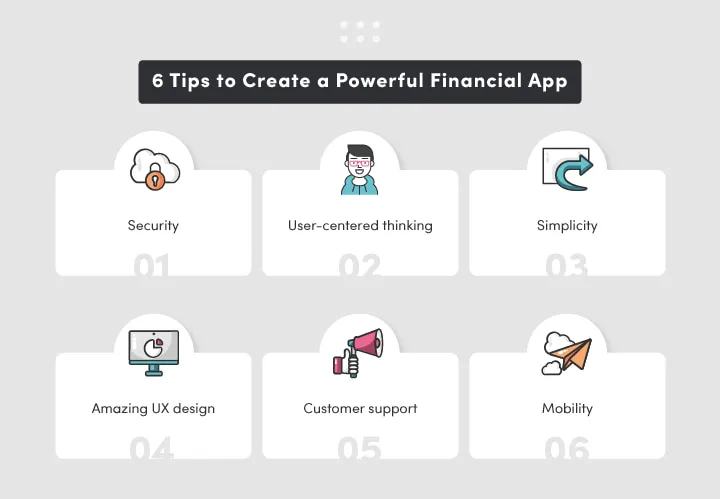
It is understandable that in spite of already having an idea of what your personal finance app will be like, the amount of information that we have discussed so far may leave you overwhelmed.
To simplify, the important points that you need to consider are those that follow.
Security
It is an obvious fact that personal finance systems deal with very sensitive and personal information, and having them fall in the wrong hands can deal a significant blow to a user’s finances - today and for the future. That is why it is important to always ensure that your app has the best security system in place, and several ways to ensure this are the following:
- Two-factor Authentication - involves having the user log in using their username and password and an added requirement that will help confirm the identity of the user. The latter can either be one-time authentication codes sent to a registered contact number or e-mail address or biometric confirmation such as facial recognition or fingerprint.
- Trusted libraries - only use libraries that have been proven to be reliable in handling sensitive financial information.
- Limit individual sessions - do not let a single user login session run for a long time in case it is the device is left unattended by its user.
These three are the most reliable measures to ensure that any information is left between the user and the app.
User-Centered Thinking
To put yourself in your user's shoes, you need to determine who they are. Most likely, it will be individuals who are having trouble managing their own finances, or as we suggested, millennials who are in need of guidance to establish a firm foundation of financial literacy.
Whoever they will be, always design the personal finance app based on their needs.
Simplicity
There is always beauty in simplicity especially in a matter as serious and heavy weighted as money management.
Always remember, the simpler you present the information to your users, the easier it is for them resulting in a more effective habitualizing proper financial management.
Amazing UX Design
As opposite as this sounds to the previous point, it actually is not.
Today’s generation is all about function and minimalism. Although, there are ways around this to ensure that it is efficient and effective as it is gorgeous. Advice from a competent UX/UI designer is the answer to your problems.
Customer Support
It has always been one of the foundations of an effective and efficient service - the reliability of those that support your users when you are not around regardless of the AI that you integrate into your personal finance app or the people who answer the problems too complex for the software to answer.
Mobility
Importantly, most users nowadays are always on the go. That is why having your app be compatible with any mobile device is necessary to the success of any app.
Read also: How to Build a Mobile Fintech App?
Technology Stack For A Personal Finance Management App
When coming up with a base concept for a money management app, there are certain things to consider before or during your work with a developer, it is important that you already have this in place.
Step 1: Choose the right technology
One of the first things to do is to choose the right technology suitable for your needs and the requirements of the app. You can choose from:
- Frontend: React.js, Angular, Vue, EmberJS, TypeScript, HTML 5, SCSS, Bootstrap, Material UI, Tailwindcss
- Backend/Api: Ruby on Rails, Node.js(Next.js, Express, NestJS), PHP(Laravel, Symfony), Java(Spring), Python(Django, Flask, Pyramid), C#(.NET)
- Database: MySQL, PostgreSQL, MongoDB, MariaDB
- Mobile app: Swift(iOS), Java(Android), Flutter(Native), React Native(Native)
- DevOps & IT Stack: Kubernetes, Heroku, Jenkins, Github, GitLab, Bitbucket, Azure, AWS
- Marketing Stack: Google AdMob, Google Tag Manager, Mailchimp, Google Sign-In, Mandrill, Segment
- Productivity & Operations Stack: G Suite, Google Drive, Google Meet, Slack
- Product & Design Stack: Figma, Adobe XD, Sketch, InVision, Webflow
- Customer Support & Success Stack: Forumbee, Intercom, Help Scout, Zendesk
- Finance & Accounting Stack: Recurly, Square
- Analytics & Data Science Stack: Amplitude, Google Analytics, VWO, Hotjar
- Other Stack: 1Password, TripActions, Mixpanel, ClickTale, Google Maps
Once you decide what you want, you can proceed to the next step.
Step 2: Design and verify a prototype
On most occasions, what this does is cut down on the time and have it released to the public as soon as possible to compete with.
For this to happen, you should already have an idea of which functions are going to be integrated into the app’s main function. Also, you should already have an idea and a list of outside developers who may have software that you think will be useful including which technology to use and the various tools to make an app both efficient and effective in saving you money.
Step 3: Build an MVP
An MVP is a prototype of an app that is tested in public to see what the initial reaction will be to what you could potentially offer. However, you need to remember that even though it is still a prototype, it must be a finished product.
Additionally, it is best if you remind your users of potential changes that may come once the beta has passed through.
Once you finish with your MVP and release it, focus on gathering feedback from the users and later implement it into the next iteration.
Summary
It is becoming apparent that money management apps are becoming a necessary tool to ensure sustainable financial stability. The studies have backed it up, even proving that individuals using these apps are wealthier than those who do not.
Hiring expert Fintech developers is a reassurance that your finished app will not only be attractive to users, but also functional, effective, and efficient in its purpose, and more importantly, user-friendly. Factors that the audience, regardless of their age and their tech-savviness, can get follow. If you would like to discuss the development of your finance application, contact us!


